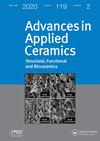Review of zirconolite crystal chemistry and aqueous durability
IF 1.6
4区 材料科学
Q3 MATERIALS SCIENCE, CERAMICS
引用次数: 18
Abstract
ABSTRACT Zirconolite (CaZrTi2O7) has been identified as a candidate ceramic wasteform for the immobilisation and disposal of Pu inventories, for which there is no foreseen future use. Here, we provide an overview of relevant zirconolite solid solution chemistry with respect to Ce, U and Pu incorporation, alongside a summary of the available literature on zirconolite aqueous durability. The zirconolite phase may accommodate a wide variety of tri- and tetravalent actinide and rare-earth dopants through isovalent and heterovalent solid solution, e.g. CaZr1–x Pu x Ti2O7 or Ca1–x PuxZrTi2–2x Fe2x O7. The progressive incorporation of actinides within the zirconolite-2M parent structure is accommodated through the formation of zirconolite polytypoids, such as zirconolite-4M or 3T, depending on the choice of substitution regime and processing route. A variety of standardised durability tests have demonstrated that the zirconolite phase exhibits exceptional chemical durability, with release rates of constituent elements typically <10−5 gm−2·d−1. Further work is required to understand the extent to which polytype formation and surrogate choice influence the dissolution behaviour of zirconolite wasteforms.锆石晶体化学与水性耐久性研究进展
摘要:锆石(CaZrTi2O7)已被确定为固定和处置Pu库存的候选陶瓷废物形式,其未来没有可预见的用途。在这里,我们提供了相关的锆石固溶体化学与Ce, U和Pu掺入的概述,以及对锆石水性耐久性的现有文献的总结。锆石相可以通过等价和异价固溶体,如CaZr1-x Pu - Ti2O7或Ca1-x PuxZrTi2-2x Fe2x O7,容纳多种三价和四价锕系元素和稀土掺杂剂。锕系元素在锆石- 2m母结构中的逐渐结合,通过形成锆石多型体,如锆石- 4m或3T,取决于替代机制和加工路线的选择。各种标准化耐久性测试表明,锆石相具有优异的化学耐久性,其组成元素的释放速率通常<10−5 gm−2·d−1。需要进一步的工作来了解多型形成和替代选择在多大程度上影响锆石废物的溶解行为。
本文章由计算机程序翻译,如有差异,请以英文原文为准。
求助全文
约1分钟内获得全文
求助全文
来源期刊

Advances in Applied Ceramics
工程技术-材料科学:硅酸盐
CiteScore
4.40
自引率
4.50%
发文量
17
审稿时长
5.2 months
期刊介绍:
Advances in Applied Ceramics: Structural, Functional and Bioceramics provides international coverage of high-quality research on functional ceramics, engineering ceramics and bioceramics.
 求助内容:
求助内容: 应助结果提醒方式:
应助结果提醒方式:


